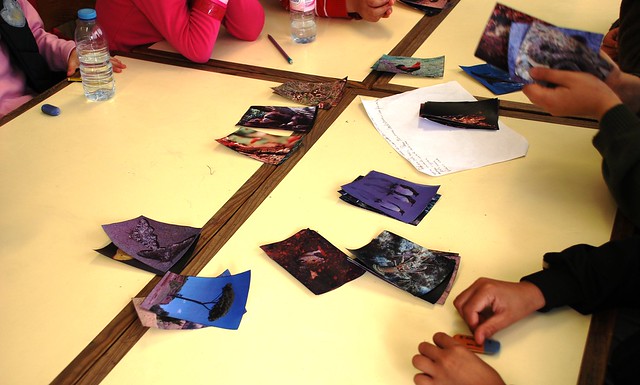
Com esta actividade pretende-se que os participantes percebam o mecanismo de evolução por deriva genética, o seu impacto na composição genética das populações e de que forma pode causar divergência entre populações/espécies. Pretende-se ainda que os participantes se apercebam dos impactos que as actividades humanas podem ter na diversidade genética de uma espécie.
Tal como a
actividade sobre Selecção Natural, esta actividade também tem vindo a ser testada em vários contextos e para vários tipos de público, tendo sido já levada a cabo para o público em geral, no âmbito de uma
exposição realizada para comemorar o “Ano Darwin”, para estudantes de secundário, no âmbito da Mostra da Universidade do Porto,
Euroskills e em salas de aula, e para alunos de escolas primárias. Irá também estar disponível na exposição “A Evolução de Darwin”, a inaugurar brevemente na Casa Andresen, Jardim Botânico do Porto.
Para introduzir esta actividade nas escolas primárias foi proposto aos alunos que previssem o impacto na diversidade e composição genética de uma população de borboletas com diversidade de cor devido à fragmentação do seu habitat (representado por um pano verde) em duas partes de diferentes tamanhos, devido à construção de uma autoestrada (representada pela pano preto). Depois de simularem a construção da autoestrada os alunos simularam ainda vários ciclos de reprodução e sobrevivência aleatória em cada uma das duas novas populações.
Antes de realizarem a actividade apenas uma pequena parte dos alunos das diferentes classes foram capazes de prever a perda mais acentuada de diversidade genética na população de menor tamanho. Após a realização da actividade os alunos perceberam que, em relação à população inicial, as duas populações alteraram a sua composição genética ao longo tempo e perderam diversidade devido ao acaso, sendo esta perda de diversidade genética inversamente proporcional ao tamanho da população. Os alunos perceberam ainda que, ao contrário do que ocorria na actividade da evolução por selecção natural, a realização desta actividade várias vezes poderia conduzir a diferentes resultados em termos da composição genética das populações, dada a aleatoriedade do processo.
Foi ainda discutido o impacto da fragmentação do habitat para a manutenção da diversidade genética das populações e sua consequente sobrevivência a longo prazo.
...
This activity was designed to make students understand how the genetic composition of a species may change due to random factors and how genetic drift may affect intraspecific diversity and cause species/populations divergence.
In order to achieve this goal we asked the students to predict the impact of a construction of a road (represented by the black cloth strip) on a population of butterflies (represented by the wood butterflies with colour diversity) initially distributed on the previously continuous habitat (represented by the green cloth). After drawing their predictions, students played the game. They randomly distributed the butterflies (six butterflies per each of the five distinct colours) on the continuous habitat and then divided this habitat in two patches of different sizes. Random survival and reproduction (represented by the blind choice of individuals from an opaque bag) was simulated several times for each of the two recently separated populations and all the results were registered.
After this activity, the students were able to understand that the two populations evolved through time becoming different from each other and from the initial population only due to random factors. They also noticed that both populations lost genetic diversity, and that the extent of the diversity loss was negatively correlated with the size of the population.
Finally the students were also able to understand that human activities that cause habitat fragmentation and that decrease populations’ sizes deeply impact the intraspecific diversity of the species.


























